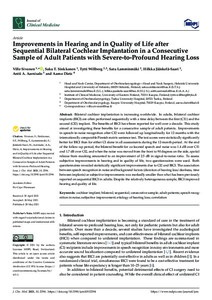Improvements in Hearing and in Quality of Life after Sequential Bilateral Cochlear Implantation in a Consecutive Sample of Adult Patients with Severe-to-Profound Hearing Loss
Aarnisalo Antti A.; Willberg Tytti; Dietz Aarno; Sinkkonen Saku T.; Lamminmäki Satu; Jääskelä-Saari Hilkka; Sivonen Ville
Improvements in Hearing and in Quality of Life after Sequential Bilateral Cochlear Implantation in a Consecutive Sample of Adult Patients with Severe-to-Profound Hearing Loss
Aarnisalo Antti A.
Willberg Tytti
Dietz Aarno
Sinkkonen Saku T.
Lamminmäki Satu
Jääskelä-Saari Hilkka
Sivonen Ville
MDPI
Julkaisun pysyvä osoite on:
https://urn.fi/URN:NBN:fi-fe2021093048040
https://urn.fi/URN:NBN:fi-fe2021093048040
Tiivistelmä
Bilateral cochlear implantation is increasing worldwide. In adults, bilateral cochlear implants (BICI) are often performed sequentially with a time delay between the first (CI1) and the second (CI2) implant. The benefits of BICI have been reported for well over a decade. This study aimed at investigating these benefits for a consecutive sample of adult patients. Improvements in speech-in-noise recognition after CI2 were followed up longitudinally for 12 months with the internationally comparable Finnish matrix sentence test. The test scores were statistically significantly better for BICI than for either CI alone in all assessments during the 12-month period. At the end of the follow-up period, the bilateral benefit for co-located speech and noise was 1.4 dB over CI1 and 1.7 dB over CI2, and when the noise was moved from the front to 90 degrees on the side, spatial release from masking amounted to an improvement of 2.5 dB in signal-to-noise ratio. To assess subjective improvements in hearing and in quality of life, two questionnaires were used. Both questionnaires revealed statistically significant improvements due to CI2 and BICI. The association between speech recognition in noise and background factors (duration of hearing loss/deafness, time between implants) or subjective improvements was markedly smaller than what has been previously reported on sequential BICI in adults. Despite the relatively heterogeneous sample, BICI improved hearing and quality of life.
Kokoelmat
- Rinnakkaistallenteet [19207]
